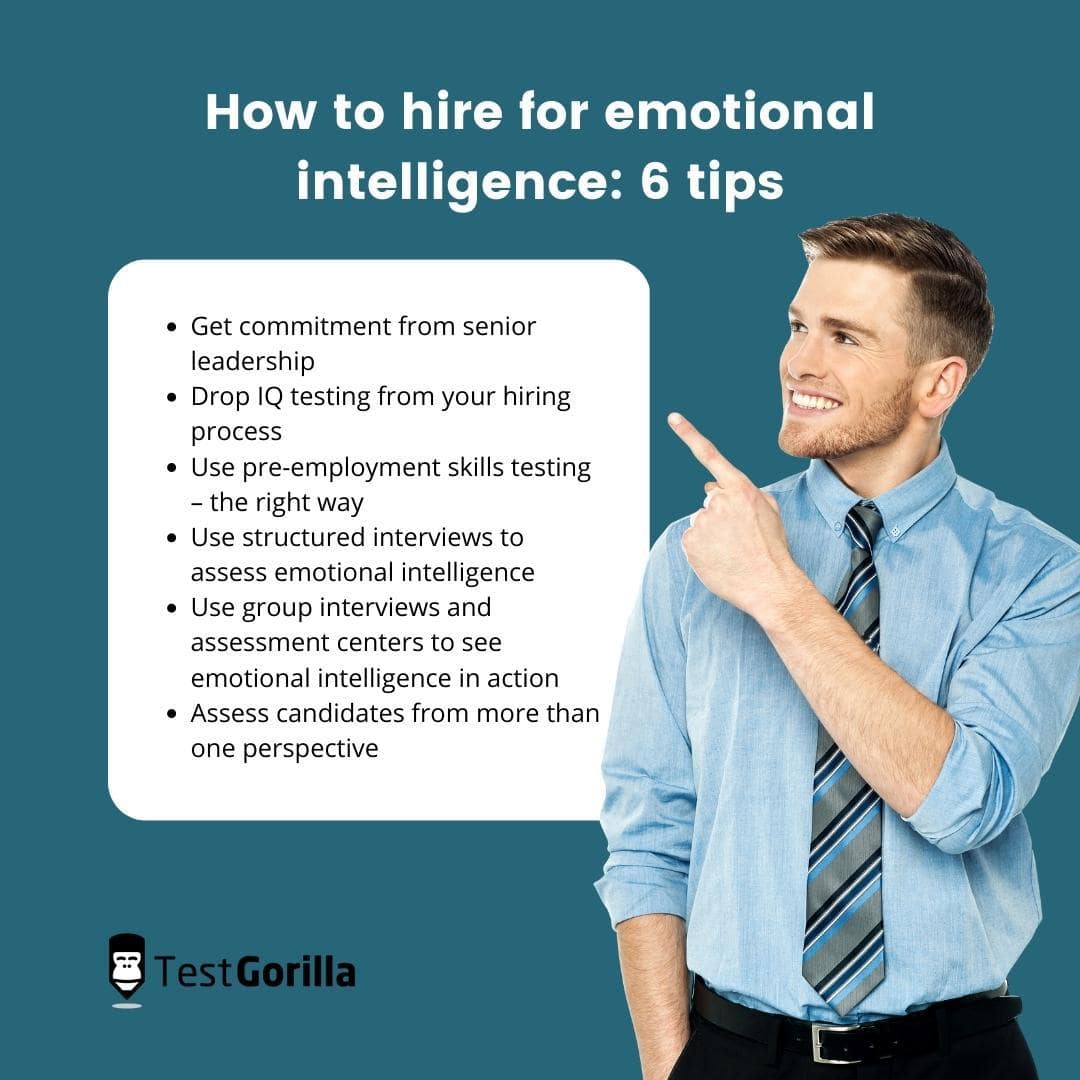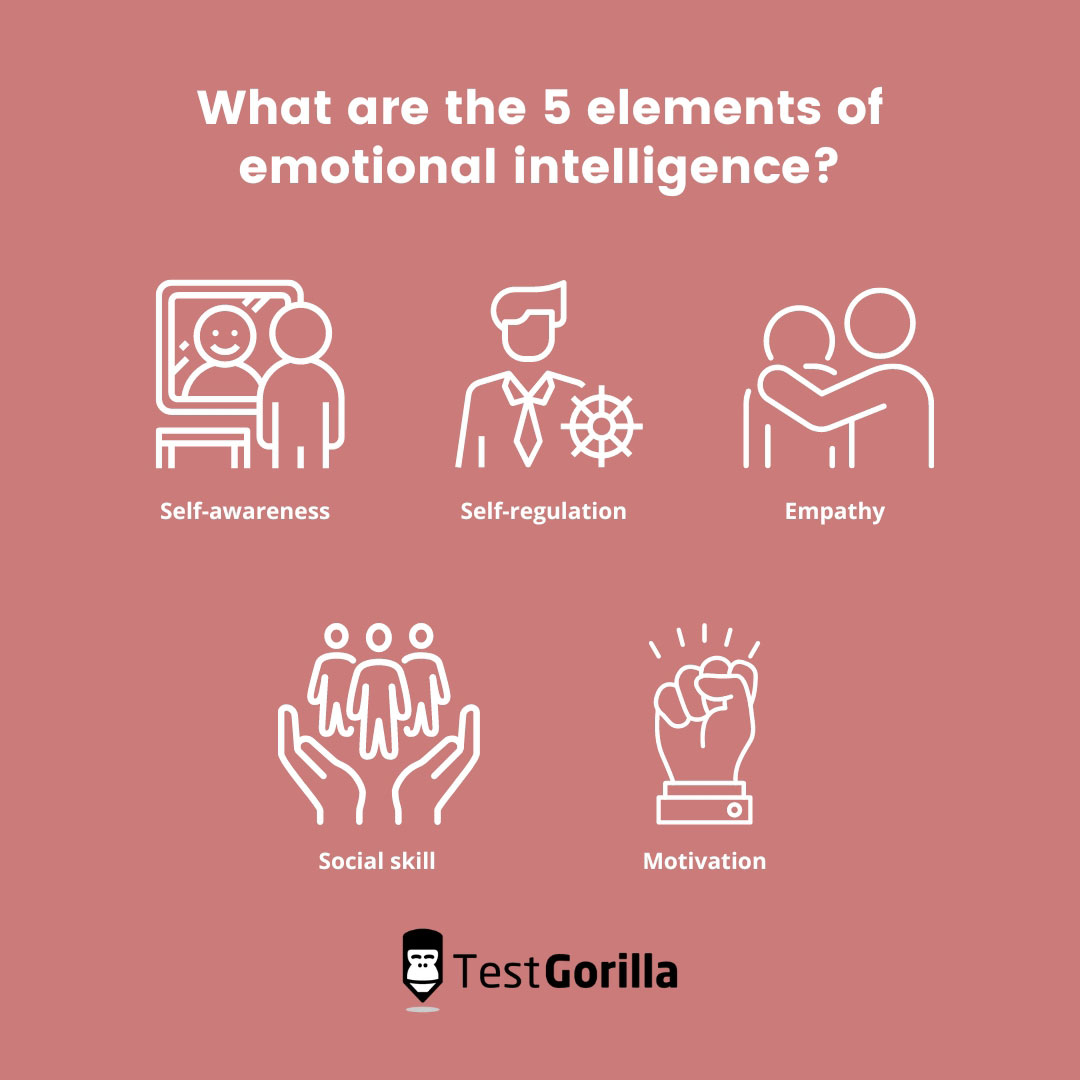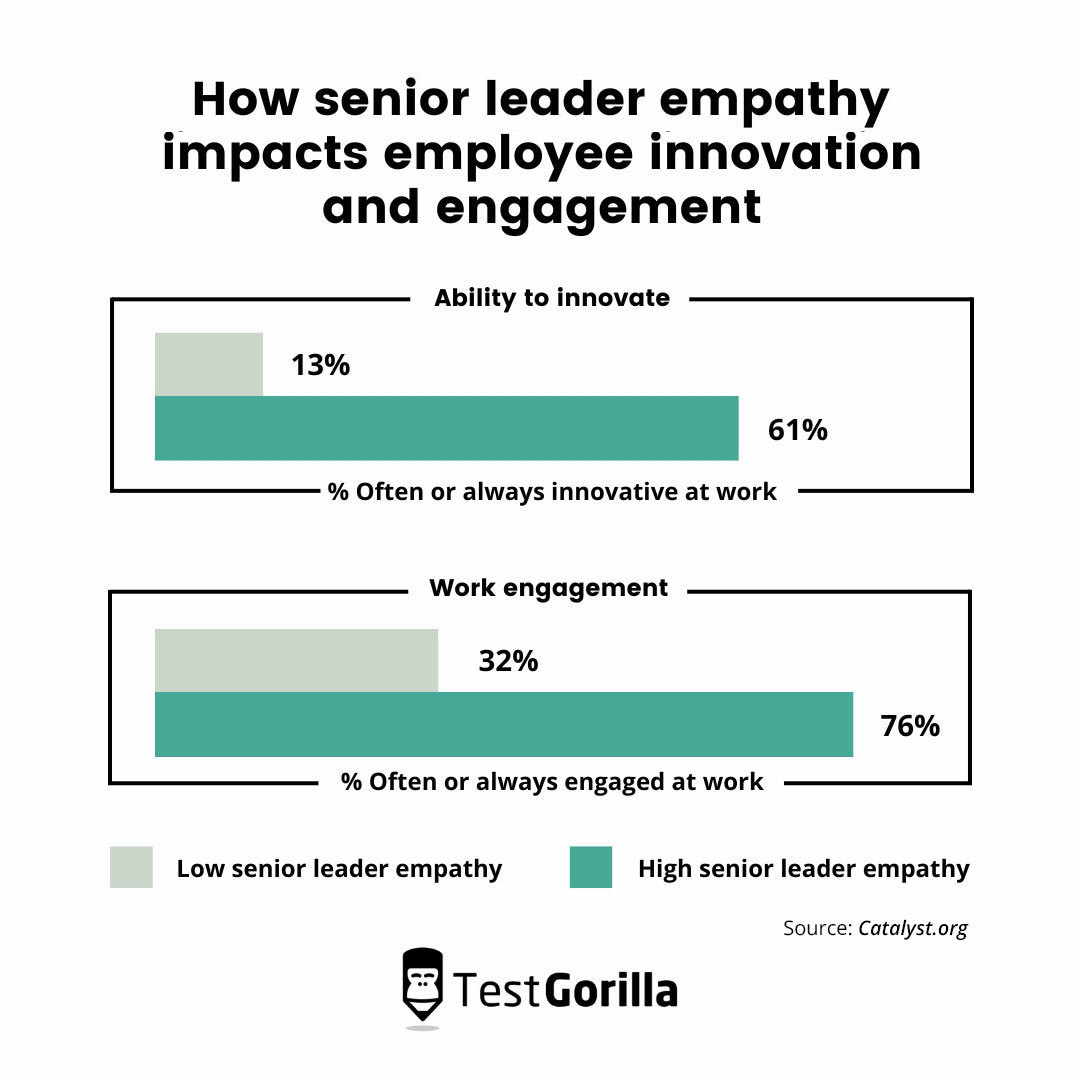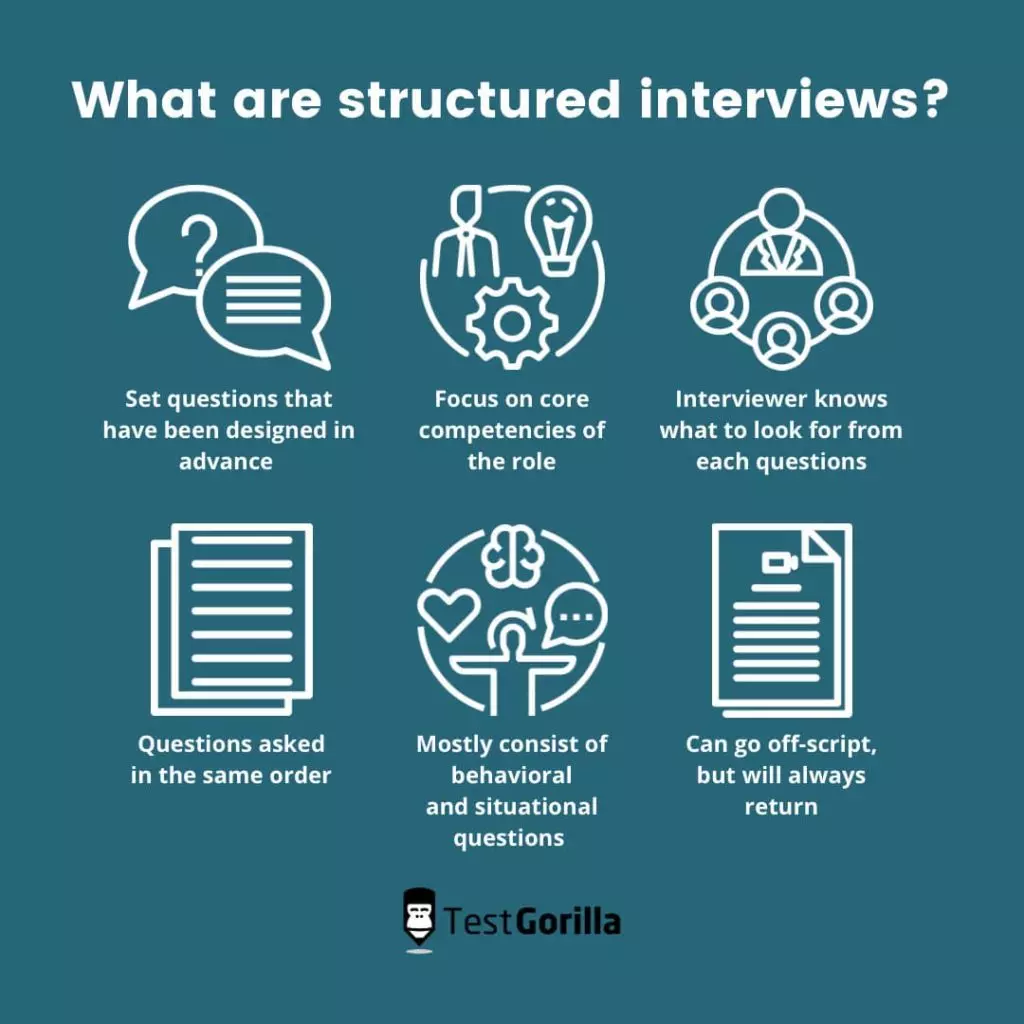Picture this: Two teams have to work overtime to meet project deadlines.
One manager doesn’t think to explain this decision. They just tell the team when they have to do the overtime, and their employees probably Google job listings on the way home.
In contrast, the other manager explains the reasoning behind their decision-making. They listen to their team’s grievances and negotiate an agreement that works for everyone. It’s not ideal, but at least the team feels like they’re in it together.
That second manager is displaying high emotional intelligence. Not only are leaders like this more likely to be effective at their jobs, but their initiatives also positively impact everything from negotiating with internal stakeholders to managing client accounts.
In this article, we’ll show you how to hire for emotional intelligence and end up with employees like the second manager – and not the first one.
We’ll start with some definitions, so if you’re already up to speed on what emotional intelligence skills are, you can skip straight to our hiring tips.
What is emotional intelligence?
Emotional intelligence, also referred to as EI or sometimes emotional quotient (EQ), refers to the ability to understand and manage your emotions and communicate effectively and empathetically with those around you.
It’s often contrasted with the intelligence quotient (IQ), which is a measure of intelligence that was developed to identify an individual’s cognitive ability, including their logic and spatial reasoning.
Unlike IQ, which has been around in one form or another for more than 100 years, EI is a relatively new term. It first came to prominence in the late 1980s and 1990s, largely thanks to the research of psychologist Daniel Goleman, who outlined his theory of emotional intelligence in his bestselling book in 1995.
What are the 5 elements of emotional intelligence?
The five elements of emotional intelligence were first described in Daniel Goleman’s book, Emotional Intelligence: Why It Can Matter More Than IQ. They cover not only how individuals experience and manage their own emotions but also how they turn these emotional experiences outward in their interactions with others.
According to Goleman, the five components of emotional intelligence are:
Self-awareness: recognizing what you’re feeling in the moment that you feel it
Self-regulation: being able to control your feelings and not act rashly because of them
Empathy: recognizing other people’s feelings, even when they don’t explicitly tell you what they are
Social skill: handling relationships with respect for the emotions of others
Motivation: directing your emotions in service of a goal – for instance, delaying gratification by waiting until your work is done to treat yourself to a night out
Some of these elements have quite clear applications in the workplace. For example, social skill and motivation are two terms we frequently use in the hiring context.
But what are some specific examples of how emotional intelligence manifests itself in the workplace?
What does emotional intelligence look like in the workplace?
Let’s start by looking at an example of two different leaders handling an emotional conversation with an employee experiencing working-from-home depression, a phenomenon that occurs when the challenges of remote work negatively affect an employee’s mental health.
Mistakes that unsupportive leaders who lack emotional intelligence make when approaching emotional conversations include:
Dismissive phrasing
Minimization
Negation
Prescribing solutions
Toxic positivity
Let’s say an employee mentions that they’ve been struggling with depression after a round of layoffs (which is not uncommon).
A leader lacking emotional intelligence might say something like: “Don’t be sad! Look on the bright side – at least you weren’t made redundant. Things could be so much worse. Everyone has bad days. Maybe just do some yoga or something.”
If we were playing “unsupportive manager bingo” right now, you would have just won. But how would a manager with high emotional intelligence react to the same statement?
The research we cited above found that, in contrast to unsupportive managers, emotionally intelligent leaders offer:
Validation
Understanding
Emotional support
Specific and actionable help
All of these were absent in the previous conversation. But a manager with an emotionally intelligent point of view might respond to the same employee like this:
“Thank you for confiding in me. Managing your mental health in times like this is hard, and I’m here to listen anytime you need me to. Would you like to take a personal day tomorrow to recharge? I’ll reach out to human resources to see what support is available through our insurance, and when you’re back, we can catch up again to discuss more accommodations to help you get back on your feet.”
This response shows appreciation for the employee’s bravery in speaking up and gives them multiple options for moving forward – whether by speaking more to their manager, taking a mental health day for their well-being, pursuing therapy, or all three.
Emotionally unintelligent leaders: | Emotionally intelligent leaders offer staff: |
Use dismissive phrasing; Minimize or negate employees’ problems; Prescribe solutions to problems without listening to employees’ needs; Practice “toxic positivity” | Validation; Understanding; Emotional support; Active listening; Specific and actionable help; A collaborative approach to problems |
Why is emotional intelligence important in the workplace?
We’ve already written a full explanation of why emotional intelligence is important in the workplace, but here’s the short version:
Being smart is only one part of being a productive employee. Managing your emotions and those of your colleagues is a much more important characteristic, especially when you combine it with the right skill set and a positive, can-do attitude.
Measuring emotional intelligence skills is a critical part of hiring great leaders. This has only become more true in the age of increased hybrid working in which leaders and managers have to manage:
Dispersed workforces that don’t work in the same room together every day
Collaborating through stilted methods of communication like Zoom
Increased economic uncertainty
Emotionally intelligent people foster teamwork and increase innovation and engagement among employees.
Measuring emotional intelligence is also important for hiring managers. The same research we referenced above found that 47% of workers with highly empathic managers reported being innovative at work, compared with only 13% of those with less empathic managers.
Employees are also more than twice as likely to report being often or always engaged if they have a highly empathetic manager.
If that’s not enough to convince you, emotional intelligence skills in managers also correlate strongly with job satisfaction among employees.
The best insights on HR and recruitment, delivered to your inbox.
Biweekly updates. No spam. Unsubscribe any time.
How to hire for emotional intelligence: 6 tips
Now you know:
What emotional intelligence means
What emotional intelligence skills look like in the workplace
The benefits of emotional intelligence
It’s time for you to learn how to assess emotional intelligence in your recruitment and selection processes.
How to hire for emotional intelligence: summary table
In a rush? Don’t worry. You can bookmark this page to come back to. In the meantime, here’s a brief summary of our tips.
Tip for hiring for emotional intelligence | Example actions |
1. Get commitment from senior leadership | Present data on how important EI is to innovation and employee satisfaction; Ask senior leadership to role model EI in its interactions with employees |
2. Drop IQ testing | Pivot toward pre-employment skills testing instead |
3. Use pre-employment skills testing – the right way | Use skills testing as one part of a larger toolkit; Implement a mix of direct and indirect testing methods |
4. Use structured interview techniques | Agree on questions and benchmarks for good answers before the interview; Use behavioral event interviewing techniques to assess specific skills |
5. Use group interviews and assessment centers | For early-career roles in which EI is important, assess candidates in groups in the first roundNote who adopts a moderating role in the conversation |
6. Assess candidates from multiple perspectives | Notice who is – and who isn’t – kind to your front-of-house staff |
1. Get commitment from senior leadership
Any good talent strategy requires support from senior leadership. However, it’s particularly important when managing the shift from traditional recruitment practices to a recruitment style that emphasizes emotional intelligence skills.
Some of the tips we give below might be hard for more old-school leaders to embrace initially, for example, shifting toward structured interviews rather than the usual unstructured approach.
However, if you can get your senior leadership on board, it will do wonders for not only your hiring but your overall talent development, helping you create a cohesive culture that values emotional intelligence.
By encouraging leaders to role model emotional intelligence skills, you’ll build an environment of psychological safety where, as we’ve already seen, innovation and engagement are significantly more likely to flourish.
McKinsey research supports this. Many of the skills it recommends leaders model to foster psychological safety for employees are tied to emotional intelligence, including:
Soliciting team members’ input on decisions that affect them
Showing concern for employees as individuals and not just workers
Asking employees to re-evaluate their assumptions about their work to reach their full potential
2. Drop IQ testing from your hiring process
We know this sounds a bit extreme, but hear us out: IQ testing is obsolete as a hiring tool.
Yes, it’s been around for nearly a century, and all of us have, at one time or another, idly googled an online IQ test (and probably given up before finishing it). But did you know that huge psychological meta-studies have questioned the validity of IQ tests for predicting job performance?
In fact, they’ve concluded that the common assumption that the more complex the job, the better an IQ test is at predicting performance is actually false.
The same studies also found that even the weak correlations between IQ and job performance you usually find in the US and Europe don’t apply globally. They’re a weak measure in the US but even worse elsewhere, which is bad news for companies hiring global teams.
If that wasn’t enough to convince you, studies also show that IQ scores can vary based on context, the test-taker’s mood, and many other factors that are almost impossible for you as a recruiter to predict or control.
If any other measure had this many flaws, you’d throw it out immediately. Just because IQ tests are recognizable and easy to compare with one another doesn’t make them a good measure for hiring.
But don’t fret; there are other empirical methods you can use in the hiring process that do have good predictive capabilities.
3. Use pre-employment skills testing – the right way
Some sources tell you to avoid pre-employment testing when assessing emotional intelligence skills.
After all, how much can an algorithm tell you about emotions?
It turns out, quite a lot – if it’s a good one and you use it right. We have a full guide on using pre-employment skills testing, but here are some pointers for using skills testing specifically for emotional intelligence.
Firstly, use a mix of direct and indirect testing methods.
One method for directly assessing emotional intelligence skills (for example, with situational-judgment questions) is using a leadership and people management test. Meanwhile, an indirect one might look at factors that inform emotional intelligence, like a business ethics test.
Secondly, make sure you’re asking the right questions. Our tests that assess emotional intelligence use multiple-choice situational-judgment questions to find out how candidates would act in difficult situations. To see what we mean, take a look at this question from our Leadership & People Management test.
This question isn’t written to catch anyone out. All of the responses would be a reasonable reaction to the situation given in the question – none of them are “wrong.”
The test-taker’s answer simply shows you how they would likely act in a real-life situation and, in combination with other questions and assessment measures, give you a picture of their emotional intelligence.
This is much more useful than just asking candidates questions like “How emotionally intelligent are you?” and receiving answers like “Super-duper emotionally intelligent, honest!”
With that said, we’re not blind to the limitations of these tools. The important thing to note is that pre-employment testing is most effective as a tool in a larger toolkit, alongside interviews, work samples, and reference checks.
This is because, as a self-reporting method, it only gives you part of the picture. After all, even though most people believe they are self-aware, it’s been estimated that only 10% to 15% of people actually are.[1]
Here are some general dos and don’ts for using pre-employment testing to assess emotional intelligence skills the right way.
Do | Don’t |
Use multiple tests of emotional intelligence – for example, communication and intrinsic motivation; Use situational-judgment tests that evaluate how a candidate would react in a given situation; Use tests to inform other methods of assessment, such as references and interviews | Just use an as a proxy for emotional intelligence; Only use self-reporting methods of assessing emotional intelligence |
4. Use structured interviews to assess emotional intelligence
When you think of a traditional job interview, it’s highly likely that you’re picturing an unstructured interview. That means:
You don’t decide the questions and benchmarks for good answers in advance
You ask every candidate different questions
You ask all of the questions in a different order
There are a lot of flaws to this approach, one of the biggest being that it’s hard to compare candidates accurately when they’ve all given you different information.
This is where the structured interview comes in. In a structured interview, you ask all candidates the same set of questions in the same order and set benchmarks for what makes a good answer before the interview. You might even score candidates’ answers to each question using these benchmarks as part of the comparison process.
At TestGorilla, we believe that a structured interview approach saves recruiters time and improves hiring decisions. Research has found that structured interviews tie with general cognitive-ability tests as the second-best predictor of job performance, having 26% accuracy.
But it’s not enough to just ask the same questions in the same order every time – you need to be smart about the questions you’re asking.
Behavioral event interviewing (BEI) is particularly effective as part of a structured interview process. This interviewing technique focuses on gleaning specific examples of target skills from each candidate. Here are some examples of weak interview questions and how they could be improved with a BEI approach.
Weak interview question | BEI alternatives | Emotional intelligence skills this measures |
What’s your greatest strength? | Tell me about a time your team achieved a big goal. What was your role in that success? What did you learn from it? | Self-awareness; Social skill; Motivation |
What’s your biggest weakness? | Tell me about a mistake you made when trying to pursue a major goal at work. How did you handle it? | Self-awareness; Self-regulation; Social skill; Motivation |
How do you handle confrontation in the work environment? | Tell me about someone who you’ve found challenging to work with. What do you do to manage this relationship? | Self-awareness; Self-regulation; Empathy; Social skill; Motivation |
5. Use group interviews and assessment centers to see emotional intelligence in action
Group interviews aren’t the most commonly used tool in a recruiter’s arsenal, perhaps because they don’t give you an opportunity to ask the candidate focused questions about their experience and the role at hand.
Don’t get us wrong, though: We don’t think they’re appropriate for every situation. Interviewing a chief executive officer, for example, is better done one on one.
However, group interviews can be useful for assessing how candidates actually behave in groups, particularly for entry-level positions. They can be extremely informative when identifying future leaders and are often used for fast-stream programs at big consultancies, accounting firms, and government organizations.
Take note of the following behaviors among participants in a group interview to identify emotional intelligence (or a lack of it):
Taking on a moderator role and ensuring that everyone speaks.
Dominating the conversation instead of giving room for others to talk.
Stepping in to summarize or mediate between conflicting points.
Taking other participants into one’s own group. A job interview isn’t a popularity contest, but emotional intelligence skills are likely to make people popular.
6. Assess candidates from more than one perspective
It’s important to remember throughout the hiring process that your perspective isn’t infallible.
The candidates you speak to probably recognize you as a decision-maker and are on their best behavior around you. This is why thinking holistically about a candidate’s interactions with your company is so important.
For instance, you should always pay attention to interviewees’ behaviors outside the interview, such as their body language, particularly if the interview occurs in person. Studies show that two of the main things that prevent managers from noticing when one of their employees is rude to others are if that employee is:
Tight with the boss
A high performer
This applies in the hiring process just as much as in the office itself. Don’t be blinded by brilliant skills test results or an affable tone in the interview. Is the candidate polite to your other employees and front desk staff, even if they don’t have anything to “gain” from these interactions? That is a key sign of emotional intelligence.
You should also be self-aware about the assessment panel for the role you’re hiring for. For instance, if you’re a male interviewer, it’s worth paying close attention to how candidates treat your female colleagues or front desk staff. Just because bias doesn’t affect you doesn’t mean you aren’t able to notice it when it happens.
Finally, reach out to a candidate’s references and actually speak to them. One study found that although 96% of recruiters conduct reference checks, they mostly do so just to confirm details like employment history rather than find out qualitative information about candidates. Don’t neglect this essential source of information.
Hire for emotional intelligence by looking for excellent communication skills
In this blog, we’ve shown you the answers to questions like:
What is emotional intelligence?
Why is emotional intelligence important in the workplace?
How can I look for emotional intelligence in candidates?
How can I be critical of my own blind spots when assessing emotional intelligence skills?
If you’re ready to get started straight away, take a look at our Communication test and incorporate it into your next round of hiring.
Or, if you want a little more explanation first, here’s our guide to workplace communication tests.
Sign up for your free plan with TestGorilla and try our tests out for yourself
Source
Eurich, Tasha. (January 4, 2018). “What Self-Awareness Really Is (and How to Cultivate It)”. Harvard Business Review. Retrieved November 8, 2022. https://hbr.org/2018/01/what-self-awareness-really-is-and-how-to-cultivate-it
Related posts
You've scrolled this far
Why not try TestGorilla for free, and see what happens when you put skills first.



















